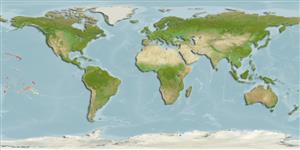Teleostei (teleosts) >
Tetraodontiformes (Puffers and filefishes) >
Ostraciidae (Boxfishes)
Etymology: Ostracion: Greek, ostrakon = shell (Ref. 45335).
Eponymy: Gilbert Percy Whitley (1903–1975) was a British-born Australian ichthyologist and malacologist. [...] (Ref. 128868), visit book page.
More on author: Fowler.
Environment: milieu / climate zone / depth range / distribution range
Ecology
Marine; reef-associated; depth range 3 - 27 m (Ref. 9710). Tropical
Eastern Central Pacific: Hawaii to the Marquesas Islands and central and eastern Polynesia.
Size / Weight / Age
Maturity: Lm ? range ? - ? cm
Max length : 15.5 cm TL male/unsexed; (Ref. 9710)
Inhabits clear lagoons and seaward reefs (Ref. 9710) as well as the quiet waters of the shore line. Benthopelagic (Ref. 58302). Feeds on algae and invertebrates (Ref. 89972).
Life cycle and mating behavior
Maturity | Reproduction | Spawning | Eggs | Fecundity | Larvae
Randall, J.E., 1996. Shore fishes of Hawai'i. Natural World Press, Vida, Oregon. 216 p. (Ref. 26145)
IUCN Red List Status (Ref. 130435: Version 2024-1)
Threat to humans
Harmless
Human uses
Fisheries: of no interest; aquarium: commercial
Tools
Special reports
Download XML
Internet sources
Estimates based on models
Preferred temperature (Ref.
123201): 24.5 - 29, mean 27.8 °C (based on 166 cells).
Phylogenetic diversity index (Ref.
82804): PD
50 = 0.5039 [Uniqueness, from 0.5 = low to 2.0 = high].
Bayesian length-weight: a=0.03548 (0.01723 - 0.07305), b=2.81 (2.62 - 3.00), in cm total length, based on LWR estimates for this (Sub)family-body shape (Ref.
93245).
Trophic level (Ref.
69278): 3.2 ±0.4 se; based on size and trophs of closest relatives
Resilience (Ref.
120179): High, minimum population doubling time less than 15 months (Fec assumed to be > 10,000).
Fishing Vulnerability (Ref.
59153): Low vulnerability (10 of 100).
Nutrients (Ref.
124155): Calcium = 70.1 [30.3, 160.8] mg/100g; Iron = 0.719 [0.371, 1.608] mg/100g; Protein = 17.9 [15.7, 20.1] %; Omega3 = 0.113 [0.057, 0.215] g/100g; Selenium = 27.4 [13.8, 56.9] μg/100g; VitaminA = 79.4 [22.6, 292.3] μg/100g; Zinc = 1.55 [1.03, 2.31] mg/100g (wet weight);
